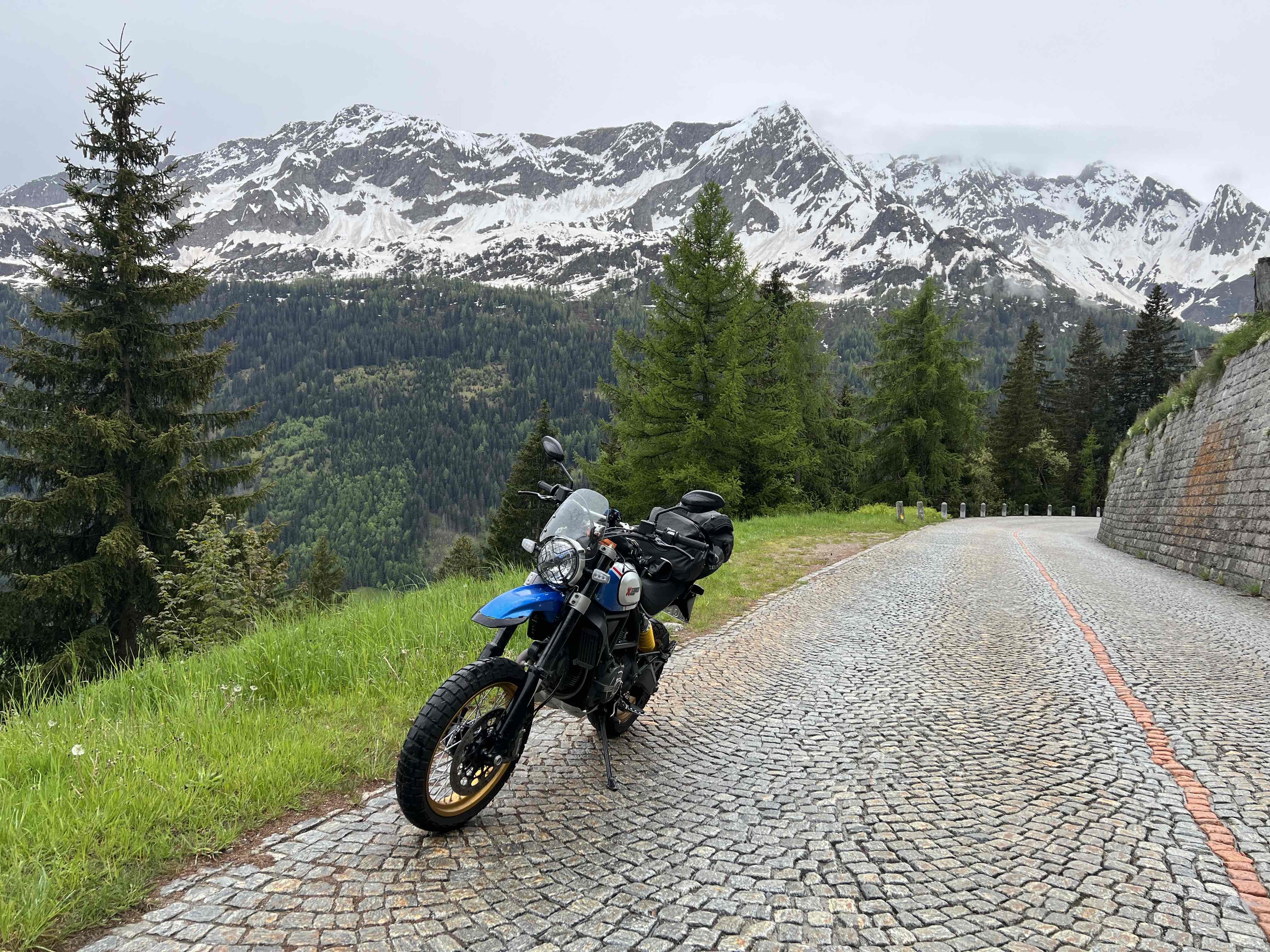I am someone who lives in a very flat area, not a single hill. Suppose I was taking a road trip and had to go up and down some mountains, what tips should I consider to be safe? How do I avoid ruining my clutch or my breaks?
In general you won’t need to worry about those things.
But if you want to worry about them… For the clutch, don’t ride it and don’t leave it in neutral. It’s ok to put it in a lower gear and let the engine do some breaking.
For breaks, you can alternate front and back if you’re worried about them over heating.
However, if you just drive normally and don’t speed then you won’t have to even think about these things.
Mountains are always eroding, you’ll find a road that was clear before might have some gravel/sand show up on it the next morning.
Ooh, damn good point
Being used to riding on flat land be aware of sight-lines being obstructed by the hill. “Hug” the fog line (not the centerline) in case oncoming traffic blows the turn an runs wide - this also enables a later apex so optimize your sightline in left handers (for right side traffic, not sure where you live)….also you may not be familiar with turning/elevation changes so take it nice and chill. Enjoy! Having gone from flat FL to mountains in CA it’s how to truly enjoy what your bike can do.
never speed on a corner you’ve never took. I ride up the Sandias at least once a month and I still don’t speed up that mountain.
Same way you do anywhere else - use them properly (seriously not being snarky, there’s really only one area where there’s a difference, which I discuss below). Keep in mind most bike clutches are wet, so have better cooling capability than cars (though BMW likes a dry clutch).
Hills aren’t really any different, and with modern vehicles brakes don’t fade like they used to (especially on bikes).
Though, since a bike does (almost always) have a manual gearbox, let engine braking handle any long downhills where you need to keep speed in check, and use brakes in short, firm decelerations.
For example, there’s a long downhill on I70 in Colorado, so long it has a sign saying “Truckers You Are Not Down Yet - 7 More Miles of Downhill”. On such a long downhill, downshift just enough that engine braking keeps you at your target speed (say 65 mph on that hill). Then if you do start running fast, or getting too close, use the brakes firmly, not lightly, to quickly bring your speed down.
This works best because it heats the brakes intensely for a few seconds, but then gives them a relatively long time to cool off afterwards.
If you were to just lightly hold the brakes to slowly slow down, the discs would heat just as much (if not more), but you’d have less time between braking cycles, leaving less time for them to cool.
I’ve experienced brake fade on such downhills, it’s no fun (in a truck). Passenger vehicles don’t often have as advanced materials in brakes as bikes do, and this particular one had relatively cheap aftermarket pads, and I had been used to it with factory pads. Big difference.
I’ve watched trucks going down such hills with their brake discs glowing hot enough to see in daylight - they had to be riding the brakes a long time for that.
Essentially, any brake system could emergency stop a vehicle at speed on such a downhill one time, so best to keep them cool for as long as possible by using engine braking.
All that said, on my 35-year-old, 700lb “sport” bike, I’ve never experienced brake fade on downhills like that. The brakes are so oversized relative to the mass of the bike, it’s just not a concern. But I still use engine braking - why take a chance.
Good comment, though I need to disagree re: quick braking based on physics principles; moto brakes are designed to handle heat load in most common environments, whether from fast hard braking or long moderate applications.
Energy cannot be created or destroyed, right? Brakes turn kinetic energy into heat, and that’s a function of clamping force.
You’re applying less clamping to your brakes over a long period, and rejecting that energy as heat. You’re in fact generating very close to the same net heat with a sharp, fast change in velocity, as between the two options what you’re really affecting is your kinetic energy.
The difference between the two options is subtle actually, quick steps allow cooling air to access the center of the brake pad between applications, long stop actions don’t. But pads and fluid are now designed to conduct heat well enough to transfer the heat away faster than it can be generated, even if cooling now only affects 5 sides instead of six. That’s the primary and crucial reason why brake fade is no longer common.
Fast breaking adds potential loss of control into the mix, so it shouldn’t be necessary or recommended.
Which is what I said - they have a longer cooling time between braking cycles.
A longer braking cycle also occurs over a longer distance and time, meaning more time for gravity to continue contributing energy to the equation. A faster deceleration between the same two speeds is less energy dissipation overall (say 70 to 60 over 5 seconds VS 30 seconds). There’s 5 seconds of additional acceleration due to gravity VS 30 seconds more.
But the biggest thing is you get a long cooling cycle instead of steadily heating the pads and rotors to simply “hold” against gravity. The rotors simply don’t have the mass the absorb and dissipate that steady, continual heat input.
Thanks for your response, friend. Last point is what I disagree with, for any bike manufactured past the late 70s. I’m clarifying that although sharp braking will lead to a seemingly cooler system, it actually isn’t a constraint because of how effective modern brake design is, and in fact invites danger through loss of control.
To the other points, brakes dissipate KE only, any sane designer will make brakes able to handle the heat load of a 140kg (300lb) rider on a 25% grade in ambient temps of 40c (104f) holding velocity steady at 50kph (30mph), all reasonable assumptions as I wouldn’t really want to ride at the edges of those specific envelopes. We’re not a truck hauling 36000kg (80000lbs), whose driver may accidentally approach the boundaries of their brake system a lot more easily.
Dot3 brake fluid is common, it’s at a 205c (400°f) boiling point and (this is key) we’ve got airflow interacting with the brake assembly over a longer period of time, while accruing less input thermal energy vs the sharp stop per moment of time.
If we sum the energy going in over the entire time vs energy going out (via air flow, fluid flow etc), the boiling point of the dot3 isn’t approached for any moto brake system designed past the late 70s, unless you’re slowly decreasing speed from a very, very high initial velocity, inputting thermal energy faster than the system can discard it.
We again reach the conclusion that within reasonable limits, holding speed steady using brakes alone won’t lead to brake fade on a bike manufactured past the 80s, no matter how long the descent.
A lot of good tips here! Came back from the alps a couple of days ago and I have one point that I did not see: it seems counterintuitive but if it gets really tight that you would have to take the turn in first gear at idle revs or below you need to give it some revs (I am at about 5k with my small single cylinder engine) and feather the clutch to regulate your speed. The revs keep your bike stable and the clutch is much better to modulate your speed than the gas.
I know this wears your clutch but they are usually oil cooled and are more robust than a lot of people think. And after all they are meant to be replaced when worn out. A clutch is cheaper than taking the shortest path down a hill because you dropped your bike 😉
Take your time on any curvy roads, and pay attention to the signs that tell you how the road is going to be, such as only one curve or switchback.
I missed a sign that a road was going to be a switchback and I almost didn’t slow down enough to turn the other direction around the second curve.
Slow down for the downhill tight turns. Turn your shoulders toward the apex. Don’t be afraid to lean a little more if you have to.
Turn your shoulders toward the apex
Yep, look where you want to go, not where you don’t want to go.
It’s so weird how our brains work - even after decades on 2 wheels, I sometimes look at what I want to avoid, and, well, I don’t avoid it then.
*brakes
don’t break your brakes on your bike, or you might break yourself.
It’s a fair question and you don’t say what your bike is so it’s hard to answer, but in general your (relatively modern) bike is tougher than you think and it will be fine. I’d say practise your slow speed and tight turns in a car park - that will help going up. Coming down, use engine and both brakes to slow before the corner - take it easy (especially if it’s damp/cold) and you will enjoy it. And you will be fine. Source: rides in mountains sometimes.

I’m not planning a trip, just realized a gap in my knowledge. Lemmy is small and needs the chatter too.
Haha still a fair question and some nice answers. And you def should plan a trip too.


